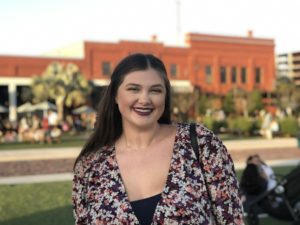
For a few weeks every summer, my mamaw walked us to the small white chapel on the other side of the open field behind her house, and we went to Vacation Bible School. We were ushered into the church basement where all twenty or so of us made name tags out of paper plates. We were spread across several folding tables filled with crafts in disarray, sitting, standing, or even dancing in our seats. Veggie Tales played on the tube TV plugged into the back wall. The leaders hole-punched the sides of the plates, helped us thread green string through the holes, and knot off the ends. The final product: a necklace with our names written in marker on the front, decorated with crayons, glitter glue, and puff balls. I decorated mine with drawings of flowers and glitter. I slung the string around my neck and wore my name tag necklace with pride. Later, we sat together in the wooden pews of the sanctuary. I learned “Father Abraham Has Many Sons,” “Zacchaeus Was a Wee Little Man,” and “I am in The Lord’s Army.” I stomped and marched and sang with a smile. Fully invested, I rejoiced in the music, the worship before I even knew what worship was, before I knew about The Spirit, and redemption.
This is my earliest memory of church. It feels warm and small, pocket-sized almost, kept safe in a wallet. It was church, it wasn’t The Church. I think about this a lot now, having not been to church in over a year, post-abortion, post-near-death, post-familial-shunning. I don’t really know exactly when it shifted from the church to The Church, from a place to an ideology.
I don’t really know exactly when it shifted from the church to The Church, from a place to an ideology.
My husband, Matthew, also grew up in The Church. His name even, representing the gospel, named for the apostle, meant to spread The Word. We met young, and married young, like most couples do in The Church. When he proposed, we already lived together. I was 21, post-near-death-accident, re-learning how to walk, bathe, and function again. He was finishing school and taking care of me. That’s how we justified it to members of the congregation with too much time and too little understanding: I needed to be taken care of, I needed help bathing; it wasn’t sexual, our living together was innocent, a product of circumstance not desire. That’s what we said, a mantra we chanted over and over, until it didn’t feel like a partial truth, until it felt like the whole truth, until I believed it.
Partial truths have always been something of a problem for me: I lived with Matt before marriage because I needed to be taken care of; I have only had sex with my husband; I almost died; I go to church; I can’t have children; I had an abortion. I don’t say the word. Not when talking about myself, not out loud at least. Abortion. It feels like it needs an explanation. The why. I had an abortion because. The because somehow makes it okay. Maybe if my because is good enough, I can still be a Christian?
***
Blood clots are a natural part of human survival. Without them, a small scrape of the knee, or nick of the razor would cause one to bleed to death. Life expectancy would be low, and the human species would surely cease to exist. The body is equipped from birth to regulate blood loss. It’s an automatic form of self-preservation. The mechanics of the body take over, regardless of conscious intent, to preserve the life within. Abnormal blood clots however, a deep vein thrombosis, or pulmonary embolism, do not know how to stop. Preservation turns into peril. The gelatinous glob of platelets and fibrin grows, blocking off the vessels and threatening the sanctity of the body.
A deep vein thrombosis, a DVT, is a blood clot of the major veins–the veins like rivers, the vital vessels–typically occurring in the legs. DVTs in and of themselves are dangerous. A DVT blocks the vessel, restricting normal blood flow, and damages the soft tissues. The leg swells as pools of blood have nowhere to go, and the surrounding muscles start to spasm uncontrollably. The leg becomes non-weight bearing, red, hot to the touch, sensitive, and occasionally rendered practically useless.
But death, death is birthed from the DVT in the form of a pulmonary embolism. An embolus, small and innocuous, millimeters or smaller breaks off of the DVT and travels through the body. The embolus lands in the lungs. Trapped initially in the microscopic tissues, it grows until the pulmonary arteries are blocked and the gas exchange is interrupted. The gas exchange occurs during respiration, when fresh oxygen is breathed in and carbon dioxide is breathed out.
Lungs unable to complete respirations are lungs that cannot breathe. Lungs that cannot breathe are housed in dead bodies. Unlike DVTs, pulmonary embolisms are hard to identify. The symptoms whisper. They are shy, found wearing the disguise of a common cold, a sore back, or a chest full of anxiety.
***
I was 20 the first time I almost died.
I was 20 the first time I almost died. A sports injury gone wrong in every conceivable way meant I was admitted to the hospital and in need of majorly invasive spinal surgery: a complete decompressive laminectomy from L3-S1. A laminectomy removes the spinal process and cuts the disc in half. The spinal process is a projection off of the back of each vertebrae, felt by running a finger down the center of the spine, the part that pushes up to the surface of the skin forming the peaks and valleys and the landscape of the body.
The laminae is the vertebral arch, the place where the muscles attach the to spine. Like a mountainous cave system, the spinal process is at the apex, the visible part of the summit. The laminae forms the structure on each side, connecting the spinal process to the base of the spine and supporting the spinal process at the top, thus creating a hollow cave-like space for the spinal cord and discs to run through.
The surgery cut through the muscles, sawed through the structure of the lamina on both sides of the vertebrae, and removed the whole spinal process, exposing the cavernous space that housed my discs and nerves. I needed this surgery because my nerves were severely pinched. I had lost the ability to stand, lost the feeling in my legs, and permanently lost feeling on the entirety of my outer of my left calf. So the laminectomy alleviated the crushing of my nerves, gave back function to my legs, and took away the majority of the pain. Surgery was long, and it was invasive, but it worked.
I knew that I would have to re-learn how to walk again. I knew that the road to recovery was going to be painful and difficult. But what I did not know was that I had a blood-clotting disorder: protein S deficiency. Or that the hormonal birth control I was on was a risk factor for blood clots. Or that blood clots were triggered by trauma to the body. So when my leg started to spasm and swell, it was no cause for concern. I was told that it was only natural that my body was reacting in such a way, that the nerves in the body are fickle, they react in funny ways after trauma, that the body corrects itself in a matter of days.
A week later I started to regress. I could no longer put any weight on my leg, let alone stand. An ultrasound showed an occluding clot from hip to ankle in the left leg. I had an emergency filter placed just below the heart in an attempt to stop pieces from traveling to my lungs and brain. When my doctor realized I already had a pulmonary embolism, I was faced with the dilemma of life or paralysis. The clots would certainly kill me without blood thinners, but blood thinners meant I would probably bleed into my spinal canal and become paralyzed because internally. I was not yet healed from the surgery.
My sister was working at the church when I found out I might die from the pulmonary embolism. The elders and prominent members were promptly informed. I was added to the prayer lists, which called upon the web of prayer warriors to speak The Word of healing over me. An Elder and his wife came to visit me one afternoon. He asked me to share with him what I was willing, and he would pray for me, pray over me. I told him partial truths (maybe they were more lies than truths): that I was trusting in the Lord; that I was thankful for his prayers; that I believed the Lord would deliver me through this trying time. I told him lies, too: that I was grateful to be alive; that I was praying for no complications; that I had no risk factors for blood clots.
A few days later, when the entirety of my family was in the hospital with me, my heart rate would not drop below 180. It felt like a rubber band was wrapped tight around my lungs, constricting the flow of air. When I tried to sit up, my heart rate spiked above 200, lingering in the danger zone for heart attacks. I was drifting out of coherence, hospital alarms started chiming around me. Nurses rushed in swiftly and within 30 seconds my room was evacuated, medication was being pumped into IVs, my bed was lowered into position for a code. I remember looking around for someone I knew; I did not want to die alone.
***
Estrogen is directly related to lowering the protein S levels in the body, in turn directly related to the increased risk of developing an abnormal blood clot. Because of this, I was told that I could no longer take birth control as it increased my risks too much. So the year following my surgery, and the first year of my marriage, we did not use hormonal birth control.
My hematologist was old-fashioned, not up-to-date on the current medical publications in regards to women’s health and birth control. Studies have shown that progesterone-only IUDs did not have any contraindications in women with hypercoagulability due to blood clotting disorders. But when I asked him about getting an IUD, he said he was not comfortable with the idea because progesterone is still a hormone.
I got pregnant at 22. My husband had just graduated with his Masters, I was still finishing undergrad. It was my first year back to school after a year of medical leave. It was not part of the plan, we were careful.
I took the pregnancy test Sunday morning before church. The two blue lines showed up right away, indicating what I already knew. Matt and I missed church that morning. Instead we sat on our couch in the living room and panicked about how we could afford to take care of a baby. I cried happy and sad.
“At least we’re not sterile,” my husband said. I did not laugh.
I called my hematologist’s office immediately. The medication I was on, Xarelto, was not pregnancy-safe. It was associated with fetal malformations in mice, never tested on humans, but I knew this. I was transferred to the on-call physician and I was prescribed Lovenox shots every 12 hours.
Lovenox shots are given in the belly, an inch to the right or left of the belly button. They are the kind of shots that burn deep for several minutes after injection, the kind that are psychologically hard to give yourself. Lovenox though, is the only pregnancy-safe anticoagulant. I did not have other options.
When I called my parents to tell them I was pregnant, I could hear the concern in their voices through the phone.
“What about you? Is this safe for you?” My dad asked.
I wanted him to be excited. I wanted the reactions that I saw on Facebook and YouTube, the jumping-with-joy kind of reactions. I wanted to believe that I would have a normal pregnancy like the girls in those videos, that the idea of a high-risk pregnancy wasn’t looming over my head.
“We already talked with the hematologist and I made an appointment with the Ob/Gyn,” I said.
I did not feel ready to have a baby, but I wanted it. I was going to make the sacrifices, give myself the shots in the stomach, eat the pregnancy foods, put my life on hold for the life of the baby. I did all of those things. Without fail.
Every morning and every night at 8 o’clock, I wiped my stomach down with an alcohol swab, grabbed myself by the thick of my fat, and stuck the needle into my stomach. I thought that the shots would get easier over time. They did not. Instead, they left subcutaneous hematomas, deep purple and black bruises that lasted for weeks in the places where I would have to inject myself again. Injection over bruise, a cycle until the whole of my stomach was covered in black quarter-size circles, edges overlapping, forming Venn diagrams of the stages of healing.
***
Protein S deficiency and pregnancy do not mix well together.
Protein S deficiency and pregnancy do not mix well together. Women who are both pregnant and have Protein S deficiency are considered to have extremely high-risk pregnancies, even while clinically anti-coagulated. They are likely to develop a DVT or pulmonary embolism, more likely to miscarry. They are unlikely to carry to full term[1], and they are more likely to die from these complications[2].
***
I told my mom that I was sexually active and needed to go on birth control after my husband and I started dating. I was expecting a spiel about sex before marriage, but she didn’t say anything. She just gave me the name and number of her gynecologist and told me to make an appointment.
When I was in late middle school, probably 13, my mom told me that every time someone has sex, they get married to each other in God’s eyes. That’s why its a big deal to have sex outside of legal marriage. I wonder if she remembers telling me that? If she knows that I still think about it? I used to think about it a lot more.
I called the gynecologist that day on my way to work and made an appointment for the following week. It was my first time at the gynecologist’s. She did a full exam before prescribing me anything. She commented on the hickey I had tried to cover up with make-up. I told her I did not want a pill, that I was not reliable enough to take it on a strict schedule. She gave me the NuvaRing. I did not ever go back to her. I was embarrassed, I felt somehow caught by her, like I was doing something naughty.
Later my mom followed up with me. She wanted to make sure that I had gotten things taken care of. I did. She said something about my dad, and responsibility. It was about abortions, I know that for sure. I knew my dad’s stance on them. He was openly pro-life. He believed in taking ownership over one’s actions, that when someone decides to have sex, they consent to the risk of pregnancy. That abortions were simply not an option.
***
I was 10 weeks pregnant when I clotted. I was fully anti-coagulated, which meant I was in treatment failure: full-blown unregulated clotting. I knew that I had a high risk of clotting during my pregnancy, but no one anticipated it to happen at 10 weeks. I was admitted to the hospital, where they inserted another filter below the heart.
This time, I was awake. I did not take any pain medication or sedatives because I did not want to risk any further harm to the baby. The filter placement procedure involved the abdomen being exposed to continuous x-rays for several minutes. It could not be placed blind and, because of this, the baby was exposed to continuous x-rays for several minutes too. But because I was in treatment failure, the clotting would only continue to get worse as the estrogen levels rose throughout the duration of the pregnancy. The exposure was a necessary evil, something that had to be done in order to help save our lives. The filter would hopefully stop the clot from traveling to the lungs or brain, but it could not stop spontaneous clots from forming. And it could not stop the current clot I had from getting bigger.
I wanted to be a good mom. In those moments, I felt I had already failed. Regardless of conscious responsibility, it felt as though who I was was not good enough to protect my baby, that even in my womb I was failing. No matter how hard I tried, I could not change the coding of my body, I could not stop the logistics of it all. No routine of medication or prenatals could negate the fact my body was sabotaging me. I would never be like the women from church who have natural water births, or get to announce their pregnancy publicly. I did not have the luxury of carrying a child that was only a child and not a life sentence. But it was my baby. It felt like a baby, even then at 10 weeks.
By the time I was released from the hospital, I was 11 weeks and had three ultrasounds. Two from before, the six- and eight-week marks, one from after the procedure to make sure everything was okay. It seemed okay, but that only made the guilt worse. When I got home, I crawled into my bed and cried. I carried the guilt of my body’s sins in my chest.
When I first found out I was pregnant, I got a few things for the baby. I bought little white, knitted booties and tacked them to the wall above my bed. I wanted something tangible, something to hold onto when I prayed. I bought a burp blanket and a newbie onesie. I put the booties on my pillow and stared at them, wondering if I would live to see a baby wear them.
A week later I had an appointment with the Ob/Gyn. They did the ultrasound first. It was the most baby-like one I had seen yet. I took a picture and texted it to my husband. We talked back and forth about nose and toes while I waited for the doctor to call me back.
He was gentle in nature. He was not mean or even direct. We talked about the possibility of delivering a stillborn baby or the clots killing me first. He said he wanted me to get a second opinion, that he was sending me to Tampa General to see the high-risk Ob/Gyn specialist.
“This is an impossible situation,” he said.
I did not cry right away. It did not sink in, not really. I knew what I heard, I understood, but it was not until I was alone in my car, driving home to tell my husband about the gravity of the circumstance did it feel real. The appointment with the high-risk Ob/Gyn was brief. She echoed similar concerns. She referred me to her colleague with a plan of action.
“Next time, we will do this right. We will plan it, monitor the blood levels more closely. Make sure that before you even start trying to get pregnant the medication is working. This doesn’t mean you can never try again,” she said. “This doesn’t mean you can never have a baby.”
***
The last time I went to church was a Sunday in August of 2018. Before then, I had not been to church in months, if not a full year. I was freshly post-abortion. Friends from the church my husband and I grew up in moved to our city. We had to keep up appearances. We could not let them know that we were no longer involved like we used to be. We were still good Christians, I swear.
They asked us where we went to church, and we said we hadn’t found a place we liked yet. They invited us to the Sunday service they were going to try out. I remember this message. Vividly. It was about grief, about leaning onto God in moments of grief, pain, and loss. The church played a video of a family who were members of the congregation. The woman sat in a chair, in front of a beautiful white background, and spoke through tears about how she lost her baby. I cried too. I did not like the way her pain was made to feel like a spectacle, meant to tug on the emotions of loss in order to lean further into The Church and The Word. I was painfully aware that I was the only one crying around me, as if I was announcing to the whole church that I, too, lost a baby.
At some point I felt a hand on my back. A gesture in the Christian world that says, “I am here for you.” I did not look to see who it was. I like to imagine it was a woman who sat behind me, that she knew the pain I was feeling, that she was trying to tell me one day I won’t cry when I talk about it, but right now it’s okay to cry.
***
I did not call my parents after the appointment with the high-risk Ob/Gyn. My mom called me the next day to check in. She was concerned. My mom is perceptive. She knew something was not right the second I answered the phone. She did not pry much. The words came out of me like vomit. Guttural, visceral, acidic. I begged my mom not to tell Dad. I did not want him to think badly of me, to think I thought of abortion as a way out, that I wanted this.
The words came out of me like vomit. Guttural, visceral, acidic.
“Termination for medical reasons,” I said.
Minutes later my father called me, I could hear through the phone the scratch of near-tears.
“Maddy, you are the most important thing,” he said.
“You won’t think badly of me?”
“No, Maddy. I love you,” he said.
Days later, with the best of intentions, my father reached out to my husband’s parents. My dad and my mother-in-law worked at the same corporation. He told her something along the lines of needing to support us in whatever decision we made. Although good at its core, I wish that my father did not do what he did. I wanted to lie to my in-laws. I did not want to deal with their judgments and opinions. I did not want them to know the truth of the pregnancy.
According to my husband’s mother, my father cornered her at work, intimidated her, and threatened her.
According to my father, he told her, “If I find out anyone is not supporting whatever decision they make, I will have choice words with them.” I guess that is the same thing.
His mom called us that evening. She and my husband got into a heated argument. She believed that God had a plan for me and the baby. She told him that she knew someone who was told to have an abortion, and they didn’t.
“The baby turned out fine,” she said. She thought we were being pressured into making a decision by the doctors. Because they were probably not Christian, they did not have our best interests at heart.
“I won’t gamble with my wife’s life, mom,” he said. He hung up the phone on her.
***
I do not remember it. Maybe it was the sedatives, maybe its repression. Probably both. I kept the knitted booties tacked to the wall until I stopped bleeding. The booties, the burp cloth, the onesie, and the ultrasounds are tucked away in a small white box in the upper left corner of my closet.
I asked my parents to tell the family that I either had a miscarriage or that I lost the baby. I did not want to explain or defend myself. They agreed.
We asked my husband’s parents to do the same thing. They, on the other hand, did not agree.
“It is a hard line in our lives. If you cannot respect our wishes on this, the relationship is over.”
“You are asking me to lie,” his mom said. “I love Jesus more than I love you. I will not sin for you, Matthew. If someone asks, I will tell them the truth.”
I think about the truth, and lies, and partial truths. What is the truth in this scenario? Are the facts the truth? I think about the facts. I come to the conclusion that facts are just partial truths, truths with no context. The facts: I was pregnant. I have a blood clotting disorder. I am angry with God. I do not forgive my husband’s family. I had an abortion.
[1] Shinozaki, Nanae. “Protein S Deficiency Complicated Pregnancy in Women With Recurrent Pregnancy Loss.” Journal of Reproductive Immunology, vol. 112, 2015. pp. 137.
[2] Horsager-Boehrer, Robyn. “What All Pregnant Women Should Know about Blood Clots: Your Pregnancy Matters: UT Southwestern Medical Center.” Your Pregnancy Matters | UT Southwestern Medical Center, 19 June 2019. Web.













